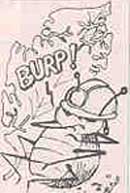Foes forever
 INSECTS, today make up the vast majority of living organisms. Although insects appeared almost 350 million years ago, they really began to diversify only after flowering plants came on the scene about 150 million years ago. The catalytic role played by flowering plants in the diversification of insects stems from the myriad ways in which plants offer themselves as food for insects.
INSECTS, today make up the vast majority of living organisms. Although insects appeared almost 350 million years ago, they really began to diversify only after flowering plants came on the scene about 150 million years ago. The catalytic role played by flowering plants in the diversification of insects stems from the myriad ways in which plants offer themselves as food for insects.
A rather elegant example of this is the case of leaf mining insects - larvae of some beetles, flies and moths. Leaf miners burrow under the surface of leaves and cat their way through as they grow, often making exquisite patterns on the leaves. The pattern in which they mine the leaves is helpful in identifying the miner species from the damaged leaf. The same can be done through fossil records of damaged leaves.
Using precisely this technique, C.C.Labandeira and colleagues at the Smithsonian Institution in Washington DC and the Universities of Florida and Connecticut (Proceedings of the US National Academy Of Sciences, No 91, 1994) have come up with new evidence that the insectplant association of leaf miners with their hosts dates back to at least 97 million years ago. The fossils used in this study came from the Dakota deposits in the states of Kansas and Nebraska, us. Two cases of leaf damage have been attributed to known living genera Stigmella and Ectodemia of the family Nepticulidae and a third one has been identified to belong to the Gracillaridae family. Since the suspected agents of the fossil leaf damage have been identified as present-day moth larvae, it appears that these particular insect-plant associations go back unbroken to at least 97 million years.
